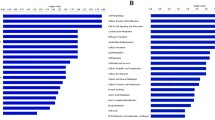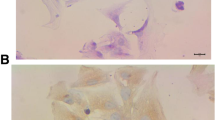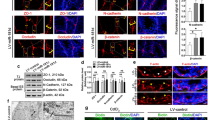Abstract
Microcystin–leucine–arginine (MC-LR) can cause male reproductive disorders. However, the underlying mechanisms are not yet fully understood. In this study, we aimed to investigate the effects of MC-LR on the integrity of blood–testis barrier (BTB) and the related molecular mechanisms. Both transepithelial electrical resistance measurement in vitro and electron microscope observation ex vivo revealed that MC-LR caused disruption of the tight junction between Sertoli cells, which was paralleled by the degradation of occludin. We observed increased expression of matrix metalloproteinase-8 (MMP-8) upon exposure to MC-LR, and confirmed that abrogation of MMP-8 activity by specific inhibitors as well as transfection with MMP-8 shRNA could abolish the degradation of occludin. Our data demonstrated that MC-LR up-regulated nuclear levels of c-Fos and c-Jun through activating ERK and JNK, and increased NF-κB levels by activating the phosphatidylinositol 3-kinase (PI3K)/AKT cascades. Enhanced binding of c-Fos and NF-κB to the promoter of MMP-8 promoted the transcription of MMP-8 gene. Furthermore, miR-184-3p was significantly downregulated in SC following exposure to MC-LR through targeting MMP-8 expression. Together, these results confirmed that MC-LR-induced MMP-8 expression was regulated at both transcriptional and post-transcriptional levels, which was involved in MC-LR-induced degradation of occludin and BTB destruction. This work may provide new perspectives in developing new diagnosis and treatment strategies for MC-induced male infertility.








Similar content being viewed by others
Abbreviations
- AP-1:
-
Activator protein-1
- BTB:
-
Blood–testis barrier
- ChIP:
-
Chromatin immunoprecipitation
- Co-IP:
-
Coimmunoprecipitation
- ECM:
-
Extracellular matrix
- ER:
-
Endoplasmic reticulum
- ES:
-
Ectoplasmic specialization
- FBS:
-
Fetal bovine serum
- MC-LR:
-
Microcystin–leucine–arginine
- MMPs:
-
Matrix metalloproteinases
- PI3K:
-
Phosphatidylinositol 3-kinase (PI3K)
- SC:
-
Sertoli cells
- TER:
-
Transepithelial electrical resistance
- TJ:
-
Tight junction
References
Chen L, Hu Y, He J, Chen J, Giesy JP, Xie P (2017) Responses of the proteome and metabolome in livers of zebrafish exposed chronically to environmentally relevant concentrations of microcystin-LR. Environ Sci Technol 51(1):596–607. doi:10.1021/acs.est.6b03990
Merel S, Walker D, Chicana R, Snyder S, Baures E, Thomas O (2013) State of knowledge and concerns on cyanobacterial blooms and cyanotoxins. Environ Int 59:303–327. doi:10.1016/j.envint.2013.06.013
Wood R (2016) Acute animal and human poisonings from cyanotoxin exposure—a review of the literature. Environ Int 91:276–282. doi:10.1016/j.envint.2016.02.026
Adamovsky O, Moosova Z, Pekarova M, Basu A, Babica P, Svihalkova Sindlerova L, Kubala L, Blaha L (2015) Immunomodulatory potency of microcystin, an important water-polluting cyanobacterial toxin. Environ Sci Technol 49(20):12457–12464. doi:10.1021/acs.est.5b02049
Chen J, Xie P, Li L, Xu J (2009) First identification of the hepatotoxic microcystins in the serum of a chronically exposed human population together with indication of hepatocellular damage. Toxicol Sci 108(1):81–89. doi:10.1093/toxsci/kfp009
Li Y, Chen JA, Zhao Q, Pu C, Qiu Z, Zhang R, Shu W (2011) A cross-sectional investigation of chronic exposure to microcystin in relationship to childhood liver damage in the Three Gorges Reservoir Region, China. Environ Health Perspect 119(10):1483–1488. doi:10.1289/ehp.1002412
Blom JF, Juttner F (2005) High crustacean toxicity of microcystin congeners does not correlate with high protein phosphatase inhibitory activity. Toxicon 46(4):465–470. doi:10.1016/j.toxicon.2005.06.013
Christen V, Meili N, Fent K (2013) Microcystin-LR induces endoplasmatic reticulum stress and leads to induction of NFkappaB, interferon-alpha, and tumor necrosis factor-alpha. Environ Sci Technol 47(7):3378–3385. doi:10.1021/es304886y
Ding J, Wang J, Xiang Z, Diao W, Su M, Shi W, Wan T, Han X (2017) The organic anion transporting polypeptide 1a5 is a pivotal transporter for the uptake of microcystin-LR by gonadotropin-releasing hormone neurons. Aquat Toxicol 182:1–10. doi:10.1016/j.aquatox.2016.11.005
Li X, Zhao Q, Zhou W, Xu L, Wang Y (2015) Effects of chronic exposure to microcystin-LR on hepatocyte mitochondrial DNA replication in mice. Environ Sci Technol 49(7):4665–4672. doi:10.1021/es5059132
Zhao Y, Xie P, Fan H (2012) Genomic profiling of microRNAs and proteomics reveals an early molecular alteration associated with tumorigenesis induced by MC-LR in mice. Environ Sci Technol 46(1):34–41. doi:10.1021/es201514h
Lin H, Liu W, Zeng H, Pu C, Zhang R, Qiu Z, Chen JA, Wang L, Tan Y, Zheng C, Yang X, Tian Y, Huang Y, Luo J, Luo Y, Feng X, Xiao G, Feng L, Li H, Wang F, Yuan C, Wang J, Zhou Z, Wei T, Zuo Y, Wu L, He L, Guo Y, Shu W (2016) Determination of environmental exposure to microcystin and aflatoxin as a risk for renal function based on 5493 rural people in southwest China. Environ Sci Technol 50(10):5346–5356. doi:10.1021/acs.est.6b01062
Zhao Y, Xue Q, Su X, Xie L, Yan Y, Wang L, Steinman AD (2016) First identification of the toxicity of microcystins on pancreatic islet function in humans and the involved potential biomarkers. Environ Sci Technol 50(6):3137–3144. doi:10.1021/acs.est.5b03369
Zhou L, Yu H, Chen K (2002) Relationship between microcystin in drinking water and colorectal cancer. Biomed Environ Sci BES 15(2):166–171
Chen Y, Xu J, Li Y, Han X (2011) Decline of sperm quality and testicular function in male mice during chronic low-dose exposure to microcystin-LR. Reprod Toxicol 31(4):551–557. doi:10.1016/j.reprotox.2011.02.006
Li Y, Sheng J, Sha J, Han X (2008) The toxic effects of microcystin-LR on the reproductive system of male rats in vivo and in vitro. Reprod Toxicol 26(3–4):239–245. doi:10.1016/j.reprotox.2008.09.004
Siu ER, Wong EW, Mruk DD, Porto CS, Cheng CY (2009) Focal adhesion kinase is a blood-testis barrier regulator. Proc Natl Acad Sci USA 106(23):9298–9303. doi:10.1073/pnas.0813113106
Wan HT, Mruk DD, Wong CK, Cheng CY (2013) The apical ES-BTB-BM functional axis is an emerging target for toxicant-induced infertility. Trends Mol Med 19(7):396–405. doi:10.1016/j.molmed.2013.03.006
Wong EW, Cheng CY (2011) Impacts of environmental toxicants on male reproductive dysfunction. Trends Pharmacol Sci 32(5):290–299. doi:10.1016/j.tips.2011.01.001
Chen Y, Zhou Y, Wang J, Wang L, Xiang Z, Li D, Han X (2016) Microcystin-leucine arginine causes cytotoxic effects in sertoli cells resulting in reproductive dysfunction in male mice. Sci Rep 6:39238. doi:10.1038/srep39238
Milward EA, Fitzsimmons C, Szklarczyk A, Conant K (2007) The matrix metalloproteinases and CNS plasticity: an overview. J Neuroimmunol 187(1–2):9–19. doi:10.1016/j.jneuroim.2007.04.010
Abdul Muneer PM, Alikunju S, Szlachetka AM, Haorah J (2012) The mechanisms of cerebral vascular dysfunction and neuroinflammation by MMP-mediated degradation of VEGFR-2 in alcohol ingestion. Arterioscler Thromb Vasc Biol 32(5):1167–1177. doi:10.1161/ATVBAHA.112.247668
Qi Z, Liang J, Pan R, Dong W, Shen J, Yang Y, Zhao Y, Shi W, Luo Y, Ji X, Liu KJ (2016) Zinc contributes to acute cerebral ischemia-induced blood-brain barrier disruption. Neurobiol Dis 95:12–21. doi:10.1016/j.nbd.2016.07.003
Qin LH, Huang W, Mo XA, Chen YL, Wu XH (2015) LPS induces occludin dysregulation in cerebral microvascular endothelial cells via MAPK signaling and augmenting MMP-2 levels. Oxid Med Cell Longev 2015:120641. doi:10.1155/2015/120641
Ren C, Li N, Wang B, Yang Y, Gao J, Li S, Ding Y, Jin K, Ji X (2015) Limb ischemic perconditioning attenuates blood-brain barrier disruption by inhibiting activity of MMP-9 and occludin degradation after focal cerebral ischemia. Aging Dis 6(6):406–417. doi:10.14336/AD.2015.0812
Ichikawa Y, Ishikawa T, Momiyama N, Kamiyama M, Sakurada H, Matsuyama R, Hasegawa S, Chishima T, Hamaguchi Y, Fujii S, Saito S, Kubota K, Hasegawa S, Ike H, Oki S, Shimada H (2006) Matrilysin (MMP-7) degrades VE-cadherin and accelerates accumulation of beta-catenin in the nucleus of human umbilical vein endothelial cells. Oncol Rep 15(2):311–315
Schubert-Unkmeir A, Konrad C, Slanina H, Czapek F, Hebling S, Frosch M (2010) Neisseria meningitidis induces brain microvascular endothelial cell detachment from the matrix and cleavage of occludin: a role for MMP-8. PLoS Pathog 6(4):e1000874. doi:10.1371/journal.ppat.1000874
Mruk DD, Cheng CY (2011) An in vitro system to study Sertoli cell blood-testis barrier dynamics. Methods Mol Biol 763:237–252. doi:10.1007/978-1-61779-191-8_16
Qiu L, Zhang X, Zhang X, Zhang Y, Gu J, Chen M, Zhang Z, Wang X, Wang SL (2013) Sertoli cell is a potential target for perfluorooctane sulfonate-induced reproductive dysfunction in male mice. Toxicol Sci 135(1):229–240. doi:10.1093/toxsci/kft129
Han JE, Lee EJ, Moon E, Ryu JH, Choi JW, Kim HS (2016) Matrix metalloproteinase-8 is a novel pathogenetic factor in focal cerebral ischemia. Mol Neurobiol 53(1):231–239. doi:10.1007/s12035-014-8996-y
Wang C, Gu S, Cao H, Li Z, Xiang Z, Hu K, Han X (2016) miR-877-3p targets Smad7 and is associated with myofibroblast differentiation and bleomycin-induced lung fibrosis. Sci Rep 6:30122. doi:10.1038/srep30122
Li Y, Han X (2012) Microcystin-LR causes cytotoxicity effects in rat testicular Sertoli cells. Environ Toxicol Pharmacol 33(2):318–326. doi:10.1016/j.etap.2011.12.015
Alexander JS, Elrod JW (2002) Extracellular matrix, junctional integrity and matrix metalloproteinase interactions in endothelial permeability regulation. J Anat 200(6):561–574
Ulitzky L, Lafer MM, KuKuruga MA, Silberstein E, Cehan N, Taylor DR (2016) A new signaling pathway for HCV inhibition by estrogen: GPR30 activation leads to cleavage of occludin by MMP-9. PLoS One 11(1):e0145212. doi:10.1371/journal.pone.0145212
Zeng R, Li X, Gorodeski GI (2004) Estrogen abrogates transcervical tight junctional resistance by acceleration of occludin modulation. J Clin Endocrinol Metab 89(10):5145–5155. doi:10.1210/jc.2004-0823
Moon SK, Cha BY, Kim CH (2004) ERK1/2 mediates TNF-alpha-induced matrix metalloproteinase-9 expression in human vascular smooth muscle cells via the regulation of NF-kappaB and AP-1: involvement of the ras dependent pathway. J Cell Physiol 198(3):417–427. doi:10.1002/jcp.10435
Shin WS, Hong Y, Lee HW, Lee ST (2016) Catalytically defective receptor protein tyrosine kinase PTK7 enhances invasive phenotype by inducing MMP-9 through activation of AP-1 and NF-kappaB in esophageal squamous cell carcinoma cells. Oncotarget 7(45):73242–73256. doi:10.18632/oncotarget.12303
Wang HH, Hsieh HL, Wu CY, Sun CC, Yang CM (2009) Oxidized low-density lipoprotein induces matrix metalloproteinase-9 expression via a p42/p44 and JNK-dependent AP-1 pathway in brain astrocytes. Glia 57(1):24–38. doi:10.1002/glia.20732
Tomek K, Wagner R, Varga F, Singer CF, Karlic H, Grunt TW (2011) Blockade of fatty acid synthase induces ubiquitination and degradation of phosphoinositide-3-kinase signaling proteins in ovarian cancer. Mol Cancer Res MCR 9(12):1767–1779. doi:10.1158/1541-7786.MCR-10-0467
Wang P, Zhang L, Hao Q, Zhao G (2011) Developments in selective small molecule ATP-targeting the serine/threonine kinase Akt/PKB. Mini Rev Med Chem 11(13):1093–1107
Yang WL, Wu CY, Wu J, Lin HK (2010) Regulation of Akt signaling activation by ubiquitination. Cell Cycle 9(3):487–497
Chen YJ, Lee YC, Huang CH, Chang LS (2016) Gallic acid-capped gold nanoparticles inhibit EGF-induced MMP-9 expression through suppression of p300 stabilization and NFkappaB/c-Jun activation in breast cancer MDA-MB-231 cells. Toxicol Appl Pharmacol 310:98–107. doi:10.1016/j.taap.2016.09.007
Yeh CB, Hsieh MJ, Hsieh YH, Chien MH, Chiou HL, Yang SF (2012) Antimetastatic effects of norcantharidin on hepatocellular carcinoma by transcriptional inhibition of MMP-9 through modulation of NF-kB activity. PLoS One 7(2):e31055. doi:10.1371/journal.pone.0031055
Zhang XX, Fu Z, Zhang Z, Miao C, Xu P, Wang T, Yang L, Cheng S (2012) Microcystin-LR promotes melanoma cell invasion and enhances matrix metalloproteinase-2/-9 expression mediated by NF-kappaB activation. Environ Sci Technol 46(20):11319–11326. doi:10.1021/es3024989
MacKintosh C, Beattie KA, Klumpp S, Cohen P, Codd GA (1990) Cyanobacterial microcystin-LR is a potent and specific inhibitor of protein phosphatases 1 and 2A from both mammals and higher plants. FEBS Lett 264(2):187–192
Chen Y, Wang J, Zhang Q, Xiang Z, Li D, Han X (2017) Microcystin-leucine arginine exhibits immunomodulatory roles in testicular cells resulting in orchitis. Environ Pollut 229:964–975. doi:10.1016/j.envpol.2017.07.081
Acknowledgements
This work was supported by National Natural Science Foundation of China (31370524, 21377052, and 31670519) and Fundamental Research Funds for the Central Universities (021414380332).
Author information
Authors and Affiliations
Corresponding authors
Ethics declarations
Conflict of interest
The authors declare no conflict of interests.
Electronic supplementary material
Below is the link to the electronic supplementary material.
Rights and permissions
About this article
Cite this article
Chen, Y., Wang, J., Pan, C. et al. Microcystin–leucine–arginine causes blood–testis barrier disruption and degradation of occludin mediated by matrix metalloproteinase-8. Cell. Mol. Life Sci. 75, 1117–1132 (2018). https://doi.org/10.1007/s00018-017-2687-6
Received:
Revised:
Accepted:
Published:
Issue Date:
DOI: https://doi.org/10.1007/s00018-017-2687-6




